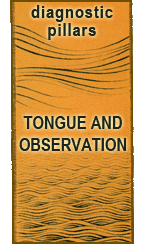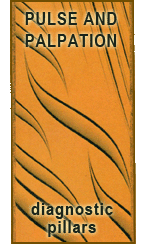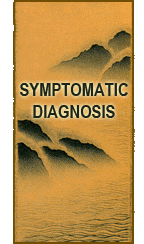Tongue Apperance and Mechanisms (A Quick Guide)

Tongue diagnosis is a powerful means by which a practitioner of Chinese medicine can quickly locate the solution to many issues of internal medicine.
What follows on this page are the various tongue body and coating appearances, how they came to look that way (mechanisms) and what they indicate.
 Last modified: September 11, 2009 ·
Last modified: September 11, 2009 ·  al ·
al ·  No Comments
No Comments
 Tags: Diagnosis, Observation, study guide · Posted in: Tongue-Observation
Tags: Diagnosis, Observation, study guide · Posted in: Tongue-Observation
Pulse Qualities and Mechanisms (A Quick Guide)

Pulse diagnosis is among the more difficult aspects of Chinese medicine to master. One reason for this is incomplete education.
In this article, pulse qualities are described, along with the mechanisms behind these findings and of course their therapeutic indications.
Understanding mechanisms simplifies this study greatly. Complex pulses such as the soggy (ru mai) aren’t so complex when you understand the basis for it’s quantifiable parameters.
 Last modified: September 11, 2009 ·
Last modified: September 11, 2009 ·  al ·
al ·  No Comments
No Comments
 Tags: Diagnosis, Palpation, study guide · Posted in: Pulse-Palpation
Tags: Diagnosis, Palpation, study guide · Posted in: Pulse-Palpation
Generalities to Guide Clinical Practice (A Quick Guide)

There are certain answers that come up frequently during the “inquiry” phase of the diagnostic interaction in Chinese medicine.
For instance, whenever you see secretions or excretions that are yellow, no matter where they appear, the diagnostic significance always points to heat.
These generalities can easily guide a practitioner toward relevant, accurate, and efficacious diagnosis. Enjoy.
 Last modified: September 11, 2009 ·
Last modified: September 11, 2009 ·  al ·
al ·  No Comments
No Comments
 Tags: Diagnosis, inquiry, Listening, Observation, Palpation, Smelling, study guide · Posted in: Inquiry
Tags: Diagnosis, inquiry, Listening, Observation, Palpation, Smelling, study guide · Posted in: Inquiry
Stray Charts from The TCM Diagnosis Study Guide (1 of 11)

These are charts describing some of the more subtle aspects of tongue diagnosis that didn’t make it into the book.
 Last modified: September 10, 2009 ·
Last modified: September 10, 2009 ·  al ·
al ·  No Comments
No Comments
 Tags: Diagnosis, Observation, study guide · Posted in: Diagnosis, Tongue-Observation
Tags: Diagnosis, Observation, study guide · Posted in: Diagnosis, Tongue-Observation
Pulse Diagnosis Made Ridiculously Simple (Page 1 of 45)

Making pulse diagnosis doable by breaking down complex qualities into very quantifiable perceptions.
 Last modified: August 27, 2009 ·
Last modified: August 27, 2009 ·  al ·
al ·  No Comments
No Comments
 Tags: Diagnosis, Palpation, study guide · Posted in: Pulse Class, Pulse-Palpation
Tags: Diagnosis, Palpation, study guide · Posted in: Pulse Class, Pulse-Palpation
Symptomatic Diagnosis: Elimination

Fecal and urinary elimination have always been an important part of health from the Chinese perspective. This article describes common issues of elimination, their differential diagnosis and herbal treatments.
Tenesmus (sense of incomplete bowel movement) – Constipation – Incontinence of feces – Incontinence of urine – Cloudy urination – Frequent urination – Oliguria, or difficult urination – Seminal fluid in urine
 Last modified: August 26, 2009 ·
Last modified: August 26, 2009 ·  al ·
al ·  No Comments
No Comments
 Tags: Diagnosis, Formulas · Posted in: Symptomatic Diagnosis
Tags: Diagnosis, Formulas · Posted in: Symptomatic Diagnosis
Symptomatic Diagnosis: Male Reproductive

This article describes a number of male reproductive issues, their differential diagnosis, treatment principles and herbal formulas. Chief complaints include:
Blood in Seminal Fluid – Thin and scanty ejaculate – Inability to ejaculate – Premature ejaculation – Nocturnal Emissions – Impotence – Persistent Erection – – Coldness in the external genitalia – Flaccid retraction of the penis – Itching and Burning in the genitalia
 Last modified: August 26, 2009 ·
Last modified: August 26, 2009 ·  al ·
al ·  No Comments
No Comments
 Tags: Diagnosis, Formulas · Posted in: Symptomatic Diagnosis
Tags: Diagnosis, Formulas · Posted in: Symptomatic Diagnosis
Symptomatic Diagnosis: Fever & Chills

Chinese medicine has a long history, back to the year 200 at least, of treating viral and bacterial infections. This article describes the differentiations, treatment principles and formulas for said infections and indications such as:
Aversion to wind and cold along with chills
Shivers or “severe chills”
Alternating fever and chills
Aversion to heat without chills
Tidal fever (low grade fever)
Five center heat
Night sweats
 Last modified: August 26, 2009 ·
Last modified: August 26, 2009 ·  al ·
al ·  No Comments
No Comments
 Tags: Diagnosis, Formulas · Posted in: Symptomatic Diagnosis
Tags: Diagnosis, Formulas · Posted in: Symptomatic Diagnosis
Symptomatic Diagnosis: Female Reproductive

Female reproductive issues make up the bulk of many a Chinese medicine herbalist’s practice. This article describes some of the key symptoms along with their differentiations, treatment principles, and formulas. Complaints include:
Light menstrual flow – Dark purple flow or thick flow – Thick menstrual flow – Thin flow – Early menstruation – Late menstruation – Amenorrhea (lack of period) – Metrorrhagia (heavy flow) – Irregular menstrual cycle – Fever during menstruation
 Last modified: August 26, 2009 ·
Last modified: August 26, 2009 ·  al ·
al ·  No Comments
No Comments
 Tags: Diagnosis, Formulas, gynecology · Posted in: Symptomatic Diagnosis
Tags: Diagnosis, Formulas, gynecology · Posted in: Symptomatic Diagnosis
Symptomatic Diagnosis: Head & Neck

Health complaints that arise from the neck and head and lumped together in Chinese medicine diagnostics. Here, we see common complaints complete with their differential diagnosis, treatment principles and formulas.
Flaccidity of neck and head due to weakened muscles – – Involuntary twitching of Head Muscles – – Tinnitus (ear ringing) – – Sore gums – – Bleeding gums – – Dark black teeth – – Stiffness of neck – – Goiter (enlargement of the thyroid gland) –
 Last modified: August 26, 2009 ·
Last modified: August 26, 2009 ·  al ·
al ·  No Comments
No Comments
 Tags: Diagnosis, Formulas, Herbs · Posted in: Symptomatic Diagnosis
Tags: Diagnosis, Formulas, Herbs · Posted in: Symptomatic Diagnosis
